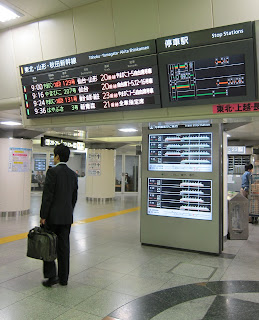You can tell a lot about a country from its trains. Consider, to stereotype wildly, the Germans (pride in efficiency and punctuality), the Dutch (cheerful utilitarianism), the Polish (working their way from the second world to the first), the Americans (they prefer cars). The same is true for the Japanese.
Most obviously, there's the impressive engineering of the shinkasen (bullet trains). Everybody loves the bullet trains. And the Japanese love to be cutting edge. The bullet trains have achieved engineering fame for Japan for the last fifty years. Cruising along at nearly 200 miles per hour, you may as well be standing still: there is no rocking, no swaying; no jostling or clicking or clacking.
Which leads us to the most remarkable aspect of riding trains in Japan: QUIET. Not only is there no noticeable train noise on the shinkasen (except when entering or exiting tunnels), but there is absolutely no talking on cell phones. It is a rule that is consistently displayed on all trains - no using mobile phones in the passenger carriages - but so discreetly that I didn't even notice it until half way through our trip. Japan is a rule-following country; following rules demonstrates respect, avoids shame, makes the community look good. If you're asked not to talk on your phone in the passenger compartments, then you don't talk on your phone in the passenger compartments. Indeed, I think it might even rise to the level of a taboo, so uniformly was the rule followed. This fundamentally alters the experience of riding on trains: it is a restful, nay even peaceful, experience. This quiet is the major reason that I suspect Jeff ranks riding the trains as his very favorite Japanese experience.
 |
| Information overload. |
Adding to Jeff's enjoyment (being an engineer and a systems guy) was the train network's precision and maximum efficiency. Trains are never late. And I don't mean more or less on time, I mean to the second. In the busiest stations, trains are spaced as close as a few minutes apart - just long enough for passengers to step on board. To ensure all runs smoothly, stations are full of information (if you know where to look - and how to decipher it) about which train carriage will stop where for a given line, and even what car you want to be on (for local trains) if you are switching at another station. Particularly busy stations have painted lanes on the platform, colored-coded by line, so passengers can queue efficiently for the rapid series of arrivals.
An illustrative example: We found ourselves passing through Osaka's main station at the beginning of a three-day weekend (unbeknown to us at the time). Three-day weekends, you should understand, are a serious matter in Japan; as one Japanese explained to me, Japan has an excessive number of national holidays (15) because the workaholic Japanese would never take vacation otherwise. Being the weekend of the second Monday in October, the entire country was celebrating Sports Day, which commemorates the 1964 Tokyo Olympics. (No, really.)
